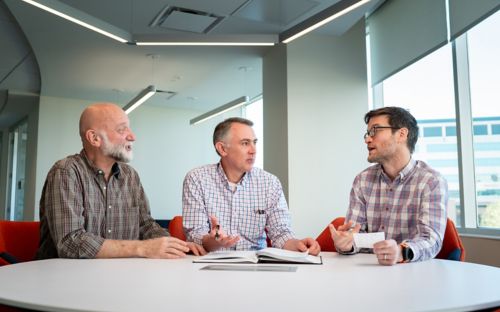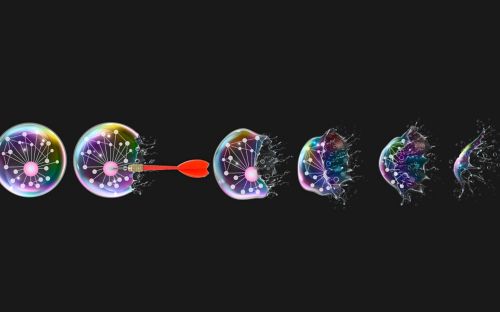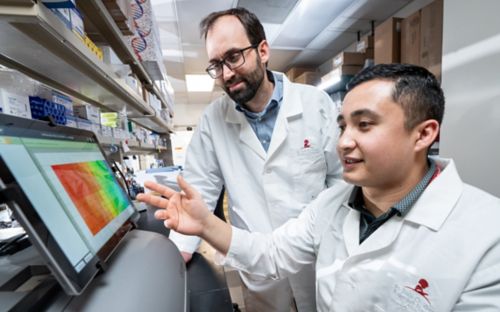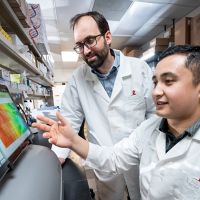Shared Resources Spotlight: Center for Advanced Genome Engineering
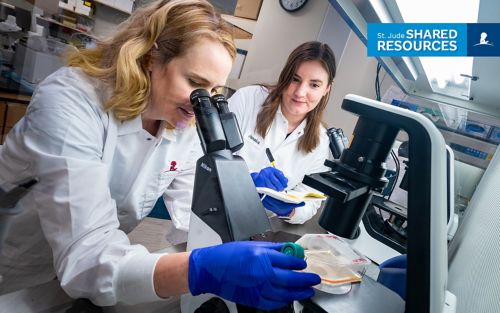
At work in the Center for Applied Genome Engineering. L to R: Shondra Pruett-Miller, PhD, and Jamaica Siwak.
Imagine a scalpel operating at the molecular level, slicing DNA with surgical precision. That’s one of the most common ways to think about CRISPR-Cas9, a gene-editing technology harnessed by the Center for Advanced Genome Engineering (CAGE) at St. Jude. CRISPR-Cas9 and other gene-editing techniques cut DNA at a precise point in the genome, allowing scientists to study specific genes and even attempt to cure some diseases.
At St. Jude, the CAGE employs gene editing to modify DNA inside cells to better model different diseases or understand the role of a gene. These approaches make the CAGE and the researchers who staff it desirable collaborators across the research enterprise.
Along with other Shared Resources – in-house services that expedite and advance research at St. Jude – the CAGE likes to stay “at the cutting edge,” according to Shondra Pruett-Miller, PhD, director of the CAGE and vice president of the Comprehensive Cancer Center Shared Resources.
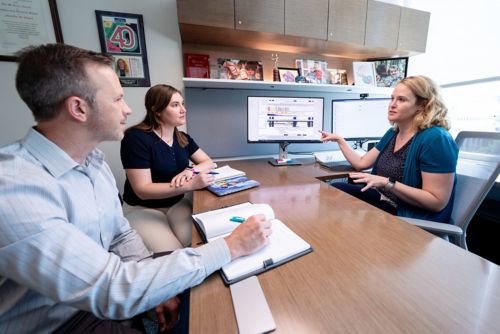
CAGE investigators Patrick Connelly, PhD, Jamaica Siwak and Shondra Pruett-Miller, PhD, discuss a project.
Cutting to the crux with CRISPR-Cas9
Intentionally modifying the genome helps scientists understand which differences in DNA cause certain results. This process allows researchers to better understand the role of different genes in different contexts and how mutations alter them.
“We can make specific changes to the language or code of the DNA so that we can model the disease to see, ‘Is this really the causative mutation that underlies this outcome?’” Pruett-Miller said.
Another strategy gaining attention is pooled CRISPR screens. This process speeds up the time it takes to compare mutations by having many cells with unique changes compete under certain conditions.
“Instead of testing one gene at a time, which is what was done several years ago, these libraries allow you to test hundreds to thousands of genes all in one experiment,” said Patrick Connelly, PhD, director of laboratory operations for the CAGE. “It's just one experiment, and, boom, you've tested thousands of genes.”
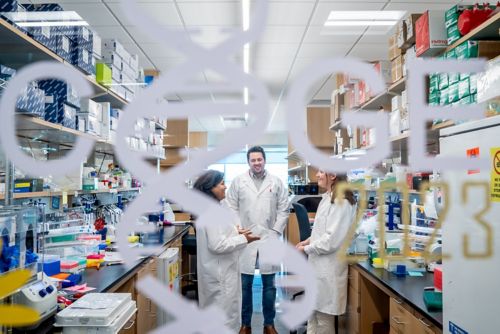
Members of the CAGE team meet in their laboratory space. L to R: Shilpa Narina, Allister Loughran, PhD, and Jamaica Siwak.
Advancing genome editing for the future
While the word “advanced” gives the CAGE a compelling acronym, Pruett-Miller said the word also has another purpose: highlighting the group’s mission.
“Our name reminds us of how we’re not going to be okay with the way it was five years ago. We’re always going to be moving with the field,” Pruett-Miller said. “It’s a good name because it goes back to our mission of advancing science.”
Jamaica Siwak is a doctoral student in the St. Jude Graduate School of Biomedical Sciences. Her work as part of Pruett-Miller's lab team embodies this mission. Rather than just relying on the tools the CAGE offers, Siwak strives to “build a better tool to study biology.”
Siwak works to maximize gene-editing outcomes. After creating a DNA break using CRISPR technology, the broken DNA can be repaired using one of two predominant DNA double-strand break repair pathways – homology-directed repair (HDR) or non-homologous end joining (NHEJ). The NHEJ pathway can put the broken ends back together but may lead to small, and typically unwanted, changes in the DNA. The more precise HDR pathway is less commonly used by mammalian cells but allows researchers to install exact, user-defined modifications in the DNA. Siwak strives to make the HDR pathway more favorable when necessary, giving it a fair chance to compete with the NHEJ pathway.
“We're living in this age of the life sciences where things can move so quickly because we are developing new and better tools,” Siwak said.
Boosting efficiency is a priority for the CAGE, ensuring researchers can optimize their time in the lab.
“On paper, it sounds easy, right? ‘Oh, I'm going to make this mutation,’ but the efficiency of HDR is really low,” Pruett-Miller said. “Jamaica Siwak is working on ways of finding the needle in the haystack.”
Along with trying to promote HDR events, CAGE members explore other ways of leveraging CRISPR-Cas9 in research and even clinical contexts. The original Cas9 protein cuts DNA, breaking through both strands of the DNA double helix, but newer variants of Cas9 can be used to simply target a specific spot in the genome with no DNA break. This allows researchers to attach other proteins to Cas9 to come along for the ride.
“Now we can take large sets of molecular machinery and move them to very specific sites in the DNA,” CAGE lead researcher Jonathon Klein said. “That’s a big research tool.”
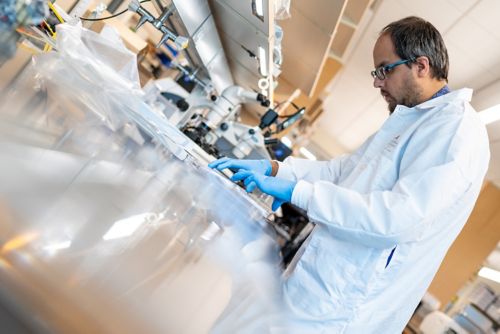
Senior Researcher Pete Hall at work in the CAGE laboratory.
Innovating across St. Jude
The CAGE is stocked with the latest technologies and highly trained researchers to use them, allowing the CAGE to help labs with specialized needs. The laboratory of Hongbo Chi, PhD, St. Jude Department of Immunology, is one of the CAGE’s many partners and focuses on cell metabolism and T-cell biology.
The Chi Lab relies on mouse models to understand the relationship between T cells and immune responses to pathogens and cancer. Before CRISPR-Cas9 technologies, studying these processes was tedious.
“You had to do it one by one, gene by gene, and it’s sometimes hard to land on the right gene to analyze because a lot of mouse models don’t have readily discernable characteristics,” said Nicole Chapman, PhD, a senior scientist in the Chi Lab. “This is partly why we moved into the CRISPR realm, to really understand how metabolism licenses these T-cell responses in different contexts in a more unbiased and systematic fashion.”
The CAGE supports the Chi Lab by generating mouse models and evaluating CRISPR-mediated gene-deletion efficiency. The Chi Lab also worked extensively with the CAGE to build CRISPR libraries of guide RNAs – RNA sequences that help Cas9 proteins reach their designated “address” – to keep up with the evolving field. This included generating a library for CRISPR-based targeting at the single-cell level.
“We needed to specialize the CRISPR library,” said Hao Shi, PhD, a senior bioinformatics research scientist in the Chi Lab. “With the help of Patrick Connelly and other staff in the CAGE, we designed a new CRISPR library that can specifically be used in single-cell-based CRISPR experiments.”
CAGE members build relationships with each other and their partners as they develop new tools, such as custom libraries, all while playing an integral role in research across various scientific departments at St. Jude.
“What’s exciting about working here is we’re constantly trying to explore and incorporate new technologies into our own research,” Connelly said. “We’re always happy to try out new things.”

